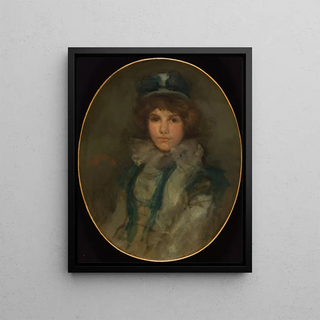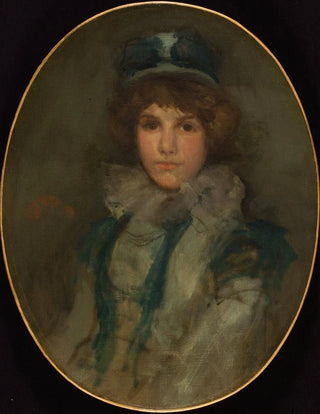Art print | Blue and Coral The Little Bonnet Blue - James Abbott McNeill Whistler


View from behind

Frame (optional)
Bleu and Coral Reproduction The Little Blue Bonnet - James Abbott McNeill Whistler – Captivating Introduction
The canvas "Blue and Coral The Little Blue Bonnet" by James Abbott McNeill Whistler is a work that embodies the very essence of Impressionism while fitting into the 19th-century artistic movement. This painting, both delicate and powerful, transports us to a universe where light and color intertwine to create a unique atmosphere. The depiction of a young woman with a blue bonnet, bathed in shades of blue and coral, evokes a sense of serenity and contemplation. As you contemplate this piece, you cannot help but feel the emotion emanating from each brushstroke, each nuance of color, as if Whistler is inviting us to immerse ourselves in a moment suspended in time.
Style and uniqueness of the work
Whistler's style, characterized by a pursuit of harmony in colors and shapes, is fully expressed in "Blue and Coral The Little Blue Bonnet." The composition, both simple and refined, highlights the silhouette of the young woman, whose blue bonnet stands out vividly against a background of coral shades. This bold use of colors creates a striking contrast, while demonstrating the artist's technical mastery. Whistler does not merely depict a human figure; he seeks to capture the very essence of his subject, to convey an atmosphere, a sensation. The fluid brushstrokes and subtle gradations testify to his innovative approach, which foreshadows 20th-century artistic movements such as Fauvism and abstraction.
The artist and his influence
James Abbott McNeill Whistler, an emblematic figure of modern art, managed to leave his mark on his era through his innovative approach and refined aesthetic. Born in 1834, this American artist spent much of his life in Europe, where he was influenced by European masters while developing a style that was uniquely his own. Whistler was a passionate advocate of the idea that art should primarily be an aesthetic experience, independent of any narration or symbolism. His famous phrase, "art is an arrangement of colors," perfectly summarizes his artistic vision. His impact on

Matte finish

View from behind

Frame (optional)
Bleu and Coral Reproduction The Little Blue Bonnet - James Abbott McNeill Whistler – Captivating Introduction
The canvas "Blue and Coral The Little Blue Bonnet" by James Abbott McNeill Whistler is a work that embodies the very essence of Impressionism while fitting into the 19th-century artistic movement. This painting, both delicate and powerful, transports us to a universe where light and color intertwine to create a unique atmosphere. The depiction of a young woman with a blue bonnet, bathed in shades of blue and coral, evokes a sense of serenity and contemplation. As you contemplate this piece, you cannot help but feel the emotion emanating from each brushstroke, each nuance of color, as if Whistler is inviting us to immerse ourselves in a moment suspended in time.
Style and uniqueness of the work
Whistler's style, characterized by a pursuit of harmony in colors and shapes, is fully expressed in "Blue and Coral The Little Blue Bonnet." The composition, both simple and refined, highlights the silhouette of the young woman, whose blue bonnet stands out vividly against a background of coral shades. This bold use of colors creates a striking contrast, while demonstrating the artist's technical mastery. Whistler does not merely depict a human figure; he seeks to capture the very essence of his subject, to convey an atmosphere, a sensation. The fluid brushstrokes and subtle gradations testify to his innovative approach, which foreshadows 20th-century artistic movements such as Fauvism and abstraction.
The artist and his influence
James Abbott McNeill Whistler, an emblematic figure of modern art, managed to leave his mark on his era through his innovative approach and refined aesthetic. Born in 1834, this American artist spent much of his life in Europe, where he was influenced by European masters while developing a style that was uniquely his own. Whistler was a passionate advocate of the idea that art should primarily be an aesthetic experience, independent of any narration or symbolism. His famous phrase, "art is an arrangement of colors," perfectly summarizes his artistic vision. His impact on






